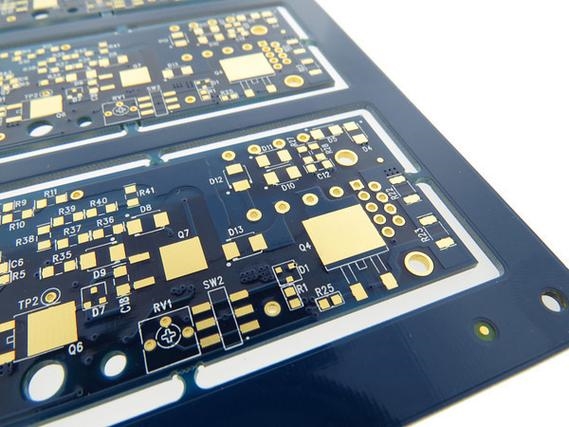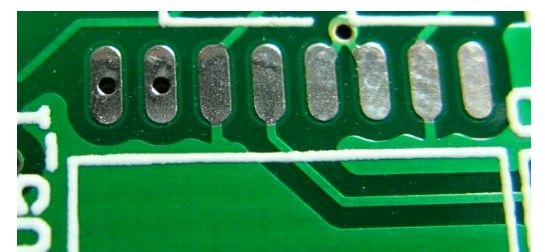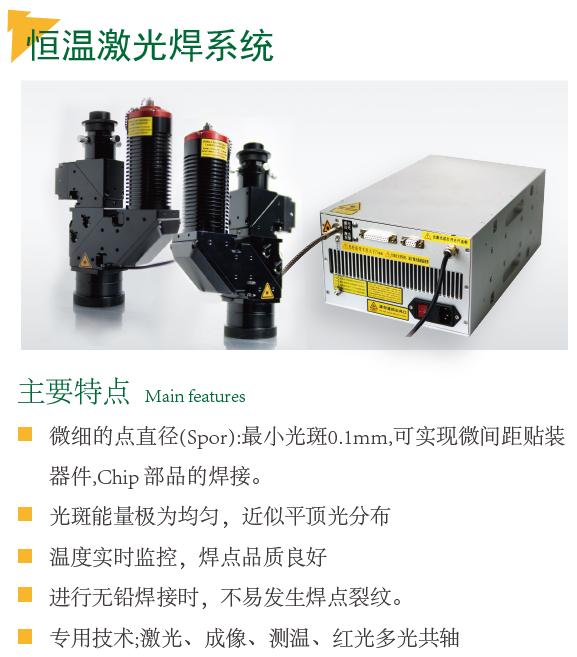Which Types of Pads Are Suitable for Laser Soldering?
Laser soldering, as a precision welding technology, is particularly suitable for pads with flat surfaces, uniform coatings, and excellent thermal stability. Based on years of prototyping experience, Songsheng Optoelectronics has found the following types of pads deliver optimal performance:

Illustration of Electroless Nickel Immersion Gold (ENIG) Pads
Electroless Nickel Immersion Gold (ENIG/Chemical Gold Plating):
Advantages: The surface is very flat with a thin gold layer (typically 0.05-0.15μm) that provides good solderability and oxidation resistance. The nickel layer acts as a barrier to prevent copper-tin diffusion and provides good mechanical strength. The flat surface ensures uniform laser energy absorption and easy control of molten solder wetting. This is currently one of the most commonly used and highly compatible options.
Note: The "black pad" issue (soldering defects caused by excessive nickel layer corrosion) must be prevented.

Electroless Silver Plated Pad Illustration
Chemical Silver Plating (ImAg/Chemical Silver):
Advantages: The surface has good flatness, and the silver layer offers excellent solderability and thermal conductivity with high laser energy absorption efficiency. The solder joints appear bright after welding, and the cost is usually lower than ENIG.
Note: The silver layer is prone to oxidation or sulfidation in air (despite organic protective films), so storage conditions and soldering time windows require
attention. Excessively thick silver layers may cause brittle solder joints (due to silver-tin intermetallic compounds).
Electroplated Soft Gold (Gold Plating):
Advantages: The surface is extremely flat with excellent oxidation resistance and very good solderability.
Note: The cost is very high. If the gold layer is too thick (>1μm), excessive gold content in the solder joint can cause brittleness (forming brittle intermetallic compounds like AuSn4), significantly affecting reliability. It is typically only used for bonding areas and is not cost-effective for ordinary solder joints.
Electroless Tin Plating (ImSn/Immersion Tin):
Advantages: The surface is relatively flat (better than HASL) at a lower cost.
Note: The tin layer may develop whiskers or oxidize during storage. During laser soldering, the thin tin layer is easily dissolved by molten solder, requiring precise laser parameter control to avoid solder voids or poor wetting. Applications with high reliability requirements should be carefully evaluated.
Less Ideal or Special-Consideration Pad Types:
Hot Air Solder Leveling (HASL):
Disadvantages: The surface is uneven (showing a "wavy" or "teardrop" shape) with inconsistent thickness. This leads to non-uniform laser energy absorption, which can easily cause localized overheating (burning pads or components), splashing, poor wetting (inability of solder to spread evenly across the pad), or cold solder joints. It is generally not recommended for laser soldering.
Organic Solderability Preservative (OSP):
Disadvantages: OSP is a thin organic protective film. The instantaneous high temperature of the laser quickly ablates and decomposes this layer. Incomplete or uneven decomposition can lead to poor wetting. During multiple soldering processes (e.g., rework), the exposed copper oxidizes easily after the protective film is destroyed. It requires very precise laser parameter control with a narrow process window, posing high reliability risks, and is generally not recommended.
Key Considerations for Pad Surface Selection:
Surface Flatness
A smooth surface ensures uniform laser energy absorption and optimal solder wetting. ENIG, ImAg, and electroplated gold provide the best flatness.
Coating Uniformity
Consistent plating thickness guarantees predictable heat conduction and uniform soldering reactions.
Solderability & Oxidation Resistance
Pads must maintain solderability before processing. Gold, silver, and tin offer natural solderability but require oxidation prevention. OSP carries the highest risk.
Thermal Stability
The pad and underlying substrate must withstand instantaneous laser heat without delamination, blistering, or discoloration.
Cost Considerations
ENIG and ImAg represent the best cost-performance balance; electroplated gold is premium-priced; HASL is lowest-cost but laser-incompatible.
Reliability Requirements
High-reliability applications (automotive/medical) prefer ENIG or tightly-controlled ImAg. Avoid thick gold layers (risk of brittle intermetallics) or oxidation-prone surfaces.
Summary:
For laser soldering applications, Electroless Nickel Immersion Gold (ENIG) and Chemical Silver Plating (ImAg) are the most widely adopted, compatible, and reliable pad surface finishes. While electroplated soft gold delivers exceptional performance, its prohibitively high cost limits practical use. Electroless Tin Plating (ImSn) can be considered but requires stringent process control. Hot Air Solder Leveling (HASL) and Organic Solderability Preservative (OSP) are generally not recommended for laser soldering due to their significant process challenges and reliability risks.
In practical implementation, beyond pad selection, precise optimization and process validation are essential—considering:
Component characteristics
Solder material (paste/wire/ball)
Laser specifications (wavelength/power/beam profile)
Process parameters (power/duration/spot size/feed rate)

Main Features:
Fine spot diameter (Spot): Minimum 0.1mm beam, enabling soldering of micro-pitch components and chip parts
Highly uniform energy distribution, approximating top-hat profile
Real-time temperature monitoring ensures high-quality solder joints
Reduced risk of solder cracks in lead-free soldering applications
Integrated technologies: Laser, imaging, temperature measurement, coaxial red light alignment
Songsheng Optoelectronics' semiconductor constant-temperature coaxial monitoring welding head is equipped with a PID online temperature regulation feedback system, which effectively achieves constant-temperature soldering to ensure welding yield and precision. The temperature control principle of Songsheng's laser soldering system is as follows: Through infrared detection, it monitors the infrared thermal radiation from the workpiece in real time, forming a closed-loop control between the laser welding temperature and the detected temperature. The self-developed PID regulation function of Songsheng's control board can effectively maintain the laser welding temperature within the set range.
Contact: Mr.Xiao
Phone: +86-13385280662
E-mail: market001@whlaser.cn
Add: Room 02, Floor 5, Building 9, Gezhouba Sun City, No. 40, Gaoxin 4th Road, Donghu New Technology Development Zone, Wuhan